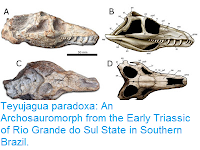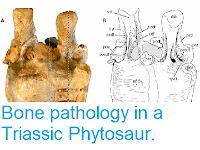The Dinosauromorpha is the wider group which includes the Dinosaurs plus any Archosaurs more closely related to the Dinosaurs than the Crocodilians. The earliest Dinosauromorph fossils are known from the Middle Triassic, though possible Dinosauromorph fossils are known from the Early Triassic of Poland, with the earliest true Dinosaurs appearing in the Late Triassic.
In a paper published in the journal Current Biology on 10 November 2016, a team of scientists led by Sergio Furtado Cabreira of the Museu de Ciências Naturais at the Universidade Luterana do Brasil describe two new Dinosauromorph species from the Late Triassic Santa Maria Formation of Rio Grande do Sul State in Brazil.
The first specimen described is a Lagerpetid, an group of small bipedal Dinosauromorphs known from South America and the southern United States, and thought to be one of the earlieat Dinosauromorph groups to appear. It is given the name Ixalerpeton polesinensis, where 'Ixalerpeton' means 'Leaping Reptile' and 'polesinensis' means 'from Polêsine; a reference to the municipality of São João do Polêsine, where the fossils were found. The species is described from a single partially articulated specimen comprising the roof of the skull and braincase, 32 vertebrae, the right scapula, left humerus, paired pelvic girdle, femur, tibia, and fibula.
The second specimen is a Sauropodomorph, a member of the early Dinosaur group from which the Sauroponds are thought to have descended. It is named Buriolestes schultzi, where 'Burio' is the name of the family who own the land on which the specimen was found, and '-lestes' means 'robber', while 'schultzi' honours the palaeontologist Cesar Schultz. The species is described from a single articulated specimen comprising a partial skull, a large number of vertebrae, the left scapula and forelimb lacking most of the manus, paired ilia and ischia, partial left pubis, and nearly complete left hind limb.
Buriolestes schultzi is particularly interesting in that it has teeth which are blade-shaped and strongly back-curved, which is strongly suggestive of a carnivorous diet, lending considerable weight to the idea that the herbivourous Sauropods were descended from smaller carnivorous ancestors.
See also...

The first specimen described is a Lagerpetid, an group of small bipedal Dinosauromorphs known from South America and the southern United States, and thought to be one of the earlieat Dinosauromorph groups to appear. It is given the name Ixalerpeton polesinensis, where 'Ixalerpeton' means 'Leaping Reptile' and 'polesinensis' means 'from Polêsine; a reference to the municipality of São João do Polêsine, where the fossils were found. The species is described from a single partially articulated specimen comprising the roof of the skull and braincase, 32 vertebrae, the right scapula, left humerus, paired pelvic girdle, femur, tibia, and fibula.
The second specimen is a Sauropodomorph, a member of the early Dinosaur group from which the Sauroponds are thought to have descended. It is named Buriolestes schultzi, where 'Burio' is the name of the family who own the land on which the specimen was found, and '-lestes' means 'robber', while 'schultzi' honours the palaeontologist Cesar Schultz. The species is described from a single articulated specimen comprising a partial skull, a large number of vertebrae, the left scapula and forelimb lacking most of the manus, paired ilia and ischia, partial left pubis, and nearly complete left hind limb.
Skeletal Features of Ixalerpeton polesinensis and Buriolestes schultzi (A–H) Ixalerpeton polesinensis. (A) Skeletal reconstruction. (B) Skull roof. (C) Braincase. (D) Pre-sacral vertebrae. (E) Sacral vertebrae. (F) Humerus. (G) Pelvis. (H) Femur. (I–P) Buriolestes schultzi. (I) Skeletal reconstruction. (J) Skull. (K) Humerus. (L) Ilium. (M) Ischium. (N) Femur. (O) Tibia and fibula proximal articulation. (P) Epipodium and pes. Some figured bones are still partially imbedded in the rock matrix, which has been digitally removed. Abbreviations are as follows: a, astragalus; ac, acetabulum; bf, brevis fossa; d, dentary; dpc, deltopectoral crest; f, frontal; fi, fibula; fm, foramen magnum; ft, fourth trochanter; hy, hyoid apparatus; il, ilium; is, ischium; j, jugal; lt, lesser trochanter; m, maxilla; mcp, medial condyle projection; mt I, metatarsal I; p, parietal; pu, pubis; pm, premaxilla; pof, postfrontal; pp, paroccipital process; qj, quadratojugal; sa, surangular; so, supraoccipital; t, tibia. Cabreira et al. (2016).
Buriolestes schultzi is particularly interesting in that it has teeth which are blade-shaped and strongly back-curved, which is strongly suggestive of a carnivorous diet, lending considerable weight to the idea that the herbivourous Sauropods were descended from smaller carnivorous ancestors.
The dentition of Buriolestes schultzi. Cabreira et al. (2016).
See also...

Follow Sciency Thoughts on Facebook.







